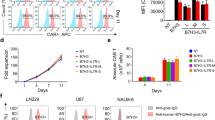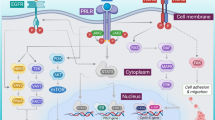Abstract
The aim of the present study was to investigate the role and molecular mechanism of human IgD (hIgD) on the proliferation of human Burkitt lymphoma Daudi cells in vitro. Logarithmically growing Daudi cells were treated with hIgD for different time periods, and cell proliferation was evaluated by cell counting kit-8 (CCK-8) assay. The expressions of Daudi surface markers and IgD receptor (IgDR) as well as cell cycle and apoptosis were measured by flow cytometry analysis. Our results showed that hIgD stimulation induced proliferation and IgDR expression and reduced the apoptosis of Daudi cells. Treatment with hIgD promoted progression of the cell cycle at the G1/S transition, and this was accompanied by upregulation of c-myc, cyclin D3, and CDK6 as well as downregulation of p16 mRNA and protein levels. Moreover, hIgD treatment also upregulated the expression of tyrosine phosphorylation of 70 kDa protein (IgDR) and p-Lyn. Taken together, these results indicate that hIgD can induce Daudi cell proliferation through activating IgDR to initiate the tyrosine phosphorylation signaling cascade to accelerate the G1/S transition.






Similar content being viewed by others
References
Pannone G, Zamparese R, Pace M, Pedicillo MC, Cagiano S, Somma P, Errico ME, Donofrio V, Franco R, De Chiara A, Aquino G, Bucci P, Bucci E, Santoro A, Bufo P. The role of EBV in the pathogenesis of Burkitt’s Lymphoma: an Italian hospital based survey. Infect Agent Cancer. 2014;9:34.
Molyneux EM, Rochford R, Griffin B, Newton R, Jackson G, Menon G, Harrison CJ, Israels T, Bailey S. Burkitt’s lymphoma. Lancet. 2012;379:1234–44.
Scheller H, Tobollik S, Kutzera A, Eder M, Unterlehberg J, Pfeil I, Jungnickel B. c-myc overexpression promotes a germinal center-like program in Burkitt’s lymphoma. Oncogene. 2010;29:888–97.
Stein H, Gerdes J, Mason DY. The normal and malignant germinal centre. Clin Haematol. 1982;11:531–59.
Oriol A, Ribera JM, Bergua J, Giménez Mesa E, Grande C, Esteve J, Brunet S, Moreno MJ, Escoda L, Hernandez-Rivas JM, Hoelzer D. High-dose chemotherapy and immunotherapy in adult Burkitt lymphoma: comparison of results in human immunodeficiency virus-infected and noninfected patients. Cancer. 2008;113:117–25.
Alwan F, He A, Montoto S, Kassam S, Mee M, Burns F, Edwards S, Wilson A, Tenant-Flowers M, Marcus R, Ardeshna KM, Bower M, Cwynarski K. Adding rituximab to CODOX-M/IVAC chemotherapy in the treatment of HIV-associated Burkitt lymphoma is safe when used with concurrent combination antiretroviral therapy. AIDS. 2015;29:903–10.
Geisberger R, Königsberger S, Achatz G. Membrane IgM influences membrane IgD mediated antigen internalization in the B cell line Bcl1. Immunol Lett. 2006;102(2):169–76.
Bergh AC, Evaldsson C, Pedersen LB, Geisler C, Stamatopoulos K, Rosenquist R, Rosén A. Silenced B-cell receptor response to autoantigen in a poor-prognostic subset of chronic lymphocytic leukemia. Haematologica. 2014;99:1722–30.
Goding JW. Allotypes of IgM and IgD receptors in the mouse: a probe for lymphocyte differentiation. Contemp Top Immunobiol. 1978;8:203–43.
Jelinek DF, Splawski JB, Lipsky PE. Human peripheral blood B lymphocyte subpopulations: functional and phenotypic analysis of surface IgD positive and negative subsets. J Immunol. 1986;136:83–92.
Nguyen TG, Little CB, Yenson VM, Jackson CJ, McCracken SA, Warning J, Stevens V, Gallery EG, Morris JM. Anti-IgD antibody attenuates collagen-induced arthritis by selectively depleting mature B-cells and promoting immune tolerance. J Autoimmun. 2010;35:86–97.
Preud’homme JL, Brouet JC, Clauvel JP, Seligmann M. Surface IgD in immunoproliferative disorders. Scand J Immunol. 1974;3:853–8.
Walzer PD, Armstrong D, Weisman P, Tan C. Serum immunoglobulin levels in childhood Hodgkin’s disease. Effect of splenectomy and long-term follow-up. Cancer. 1980;45:2084–9.
Biggar RJ, Christiansen M, Rostgaard K, Smedby KE, Adami HO, Glimelius B, Hjalgrim H, Melbye M. Immunoglobulin subclass levels in patients with non-Hodgkin lymphoma. Int J Cancer. 2009;124:2616–20.
Brezniak N, Shtrasburg S, Langevitz P, Livneh A, Drenth JP, Shtrasburg S, Langevitz P. Serum IgD as a discriminator between the two periodic febrile syndromes hyperimmunoglobulinaemia D syndrome and Behçet’s disease. Ann Rheum Dis. 1998;57:255–6.
Kholmogorova GT, Stefani DV. Levels of IgD in patients with rheumatoid arthritis. Allergol Immunopathol (Madr). 1982;10:211–4.
Coico RF, Tamma SL, Bessler M, Wei CF, Thorbecke GJ. IgD-receptor-positive human T lymphocytes. I. Modulation of receptor expression by oligomeric IgD and lymphokines. J Immunol. 1990;145:3556–61.
Coico RF, Xue B, Wallace D, Pernis B, Siskind GW, Thorbecke GJ. T cells with receptors for IgD. Nature. 1985;316:744–6.
Coico RF, Siskind GW, Thorbecke GJ. Role of IgD and T delta cells in the regulation of the humoral immune response. Immunol Rev. 1988;105:45–67.
Amin AR, Swenson CD, Xue B, Ishida Y, Nair BG, Patel TB, Chused TM, Thorbecke GJ. Regulation of IgD-receptor expression on murine T cells. II. Upregulation of IgD receptors is obtained after activation of various intracellular second-messenger systems; tyrosine kinase activity is required for the effect of IgD. Cell Immunol. 1993;152:422–39.
Lakshmi Tamma SM, Wu Y, Toporovsky I, Lima V, Coico RF. IgD receptor-mediated signal transduction in T cells. Cell Immunol. 2001;207:110–7.
Rudders RA, Andersen J. IgD-Fc receptors on normal and neoplastic human B lymphocytes. Clin Exp Immunol. 1982;50:579–86.
Lisanti MP, Sargiacomo M. Biotinylation and analysis of membrane-bound and soluble proteins. Curr Protoc Immunol. 2001;Chapter 8:Unit 8.16.
Peng Z, Fisher R, Adkinson NF Jr. Total serum IgD is increased in atopic subjects. Allergy. 1991;46:436–44.
Mulders-Manders CM, Simon A. Hyper-IgD syndrome/mevalonate kinase deficiency: what is new? Semin Immunopathol. 2015;37:371–6.
Carey GB, Scott DW. Role of phosphatidylinositol 3-kinase in anti-IgM and anti-IgD-induced apoptosis in B cell lymphomas. J Immunol. 2001;166:1618–26.
Tavolaro S, Peragine N, Chiaretti S, Ricciardi MR, Raponi S, Messina M, Santangelo S, Marinelli M, Di Maio V, Mauro FR, Del Giudice I, Foà R, Guarini A. IgD cross-linking induces gene expression profiling changes and enhances apoptosis in chronic lymphocytic leukemia cells. Leuk Res. 2013;37:455–62.
Wu Y, Lakshmi Tamma SM, Lima V, Coico R. Facilitated antigen presentation by B cells expressing IgD when responding T cells express IgD-receptors. Cell Immunol. 1999;192:194–202.
Sánchez-Beato M, Camacho FI, Martínez-Montero JC, Sáez AI, Villuendas R, Sánchez-Verde L, García JF, Piris MA. Anomalous high p27/KIP1 expression in a subset of aggressive B-cell lymphomas is associated with cyclin D3 overexpression. p27/KIP1-cyclin D3 colocalization in tumor cells. Blood. 1999;94:765–72.
Doglioni C, Chiarelli C, Macrí E, Dei Tos AP, Meggiolaro E, Dalla Palma P, Barbareschi M. Cyclin D3 expression in normal, reactive and neoplastic tissues. J Pathol. 1998;185:159–66.
Filipits M, Jaeger U, Pohl G, Stranzl T, Simonitsch I, Kaider A, Skrabs C, Pirker R. Cyclin D3 is a predictive and prognostic factor in diffuse large B-cell lymphoma. Clin Cancer Res. 2002;8:729–33.
Schmitz R, Young RM, Ceribelli M, Jhavar S, Xiao W, Zhang M, Wright G, Shaffer AL, Hodson DJ, Buras E, Liu X, Powell J, Yang Y, Xu W, Zhao H, Kohlhammer H, Rosenwald A, Kluin P, Müller-Hermelink HK, Ott G, Gascoyne RD, Connors JM, Rimsza LM, Campo E, Jaffe ES, Delabie J, Smeland EB, Ogwang MD, Reynolds SJ, Fisher RI, Braziel RM, Tubbs RR, Cook JR, Weisenburger DD, Chan WC, Pittaluga S, Wilson W, Waldmann TA, Rowe M, Mbulaiteye SM, Rickinson AB, Staudt LM. Burkitt lymphoma pathogenesis and therapeutic targets from structural and functional genomics. Nature. 2012;490:116–20.
Klangby U, Okan I, Magnusson KP, Wendland M, Lind P, Wiman KG. p16/INK4a and p15/INK4b gene methylation and absence of p16/INK4a mRNA and protein expression in Burkitt’s lymphoma. Blood. 1998;91:1680–7.
Guan H, Xie L, Klapproth K, Weitzer CD, Wirth T, Ushmorov A. Decitabine represses translocated MYC oncogene in Burkitt lymphoma. J Pathol. 2013;229:775–83.
Cavalheiro GR, Matos-Rodrigues GE, Gomes AL, Rodrigues PM, Martins RA. c-myc regulates cell proliferation during lens development. PLoS ONE. 2014;9:e87182.
Schuhmacher M, Eick D. Dose-dependent regulation of target gene expression and cell proliferation by c-myc levels. Transcription. 2013;4:192–7.
Jaso-Friedmann L, Leary JH, Evans DL. Monoclonal antibody binding to a receptor on nonspecific cytotoxic cells (NCC) increases the expression of proto-oncogene kinases and protein kinase C. Cell Signal. 1995;7:463–70.
Tamma SM, Coico RF. IgD-receptor-positive human T lymphocytes. II. Identification and partial characterization of human IgD-binding factor. J Immunol. 1992;148:2050–7.
Gross AJ, Proekt I, DeFranco AL. Elevated BCR signaling and decreased survival of Lyn-deficient transitional and follicular B cells. Eur J Immunol. 2011;41:3645–55.
Scapini P, Pereira S, Zhang H, Lowell CA. Multiple roles of Lyn kinase in myeloid cell signaling and function. Immunol Rev. 2009;228:23–40.
Ingley E. Functions of the Lyn tyrosine kinase in health and disease. Cell Commun Signal. 2012;10:21.
Je DW, O YM, Ji YG, Cho Y, Lee DH. The inhibition of SRC family kinase suppresses pancreatic cancer cell proliferation, migration, and invasion. Pancreas. 2014;43:768–76.
Acknowledgments
This work was supported by the National Nature Science Foundation of China (Nos. 81330081, 81302784, 81302845, and 31200675), Specialized Research Fund for the Doctoral Program of Higher Education (Nos. 20113420120006 and 20123420110003), Program for Tackling Key Problems in Science and Technology by Anhui Province (No. 1301042098), Anhui Provincial Natural Science Foundation (No. 1408085QH173), and Anhui Medical University Foundation (No. 2015xkj012).
Authors’ contributions
XD designed and performed experiments and wrote the manuscript. YJW participated in experiments, performed the statistical analysis, and revised the manuscript. XYJ participated in the design of the study and revised the manuscript. HSC and WSC carried out the flow cytometry, PCR, and western blot assays. CW and YC performed the statistical analysis and helped to revise the manuscript. HXW and QH interpreted data and helped to revise the manuscript. WW conceived of the study and revised the manuscript. All authors read and approved the manuscript.
Author information
Authors and Affiliations
Corresponding author
Ethics declarations
Conflict of interest
The authors have no conflict of interest to declare.
Additional information
Xing Dai and YuJing Wu have contributed equally to this work.
Rights and permissions
About this article
Cite this article
Dai, X., Wu, Y., Jia, X. et al. hIgD promotes human Burkitt lymphoma Daudi cell proliferation by accelerated G1/S transition via IgD receptor activity. Immunol Res 64, 978–987 (2016). https://doi.org/10.1007/s12026-015-8777-3
Published:
Issue Date:
DOI: https://doi.org/10.1007/s12026-015-8777-3




